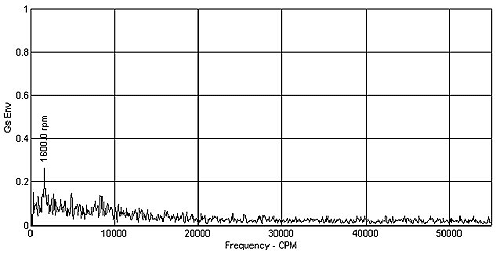Acceleration envelope measurements are a new
introduction to the inventory available to vibration analysts. Although initially it would
seem to be most useful for detecting rolling element bearing defects (BPFO, BPFI, BSF,
FTF), much more can be performed once the frequency ranges and applications of other more
traditional vibration parameters are considered. Once it is understood how acceleration
envelope signals are processed, nearly all analysis could be accomplished with these
signals. Phenomena associated with motor electrical and gear meshing problems fall into
the frequency range of acceleration envelope processing. Unbalance and other lower order
problems do not initially fall into envelope analysis, but as these problems degrade they
can be detected.
Acceleration envelope signatures are essentially band passed signals
where lower order and higher order frequencies are removed. The remaining frequency range
is most commonly associated with bearing defect frequencies. Normally, running speed
related frequencies are removed by the filters and are not present in acceleration
envelope spectra. However, when a running speed order frequency becomes severe enough it
will appear in the envelope signature. This is due to the presence of numerous harmonics
of the lower order frequency, which are not detectable in velocity signals, falling into
the envelope filter range.
Figures 1 and 2 illustrate that when lower velocity signals are present the running
speed components will not be present in acceleration envelope signatures. These spectra
were collected on the same day during a routine PM data collection visit.

Figure 1
Acceleration envelope measurements were taken on same day. Note that 1Xrpm is missing in
Figure 2 due to the filtering used (30k-600k cpm). Also, note the low noise floor and the
lack of bearing frequencies in the spectrum. This bearing had recently been installed, no
defects were identifiable, and the lubrication is adequate for continued operation.

Figure 2
As the running speed components and their harmonics become larger along with the presence
of higher order harmonics the "ringing" associated with these harmonically
related frequency components fall into the frequency range of the acceleration envelope
measurements. Running speed frequencies are now present in acceleration envelope
measurements. Figures 3 and 4 illustrate this phenomenon.

Figure 3
The velocity spectrum, figure 3, has a much larger 1Xrpm frequency component which now
appears in the acceleration envelope spectrum, figure 4.

Figure 4
LUBRICATION
Lubrication problems, not normally analyzed with velocity signatures, but can sometimes be
detected in acceleration signatures, can readily be detected using acceleration envelope
signatures. Experience has shown that an inadequate lubrication condition will cause a
shift in the noise floor of the signature.
Inadequate lubrication, which can encompass
insufficient quantity, excessive quantity, and/or improper specifications, can be readily
identified using acceleration envelope measurements. This phenomenon manifests itself as a
shifting of the noise floor. Properly installed and operating bearings will not
necessarily generate specific bearing defect frequencies when an inadequate lubrication
condition exists.

Figure 5
Figure 5 illustrates how a lubrication problem can be identified. The left portion of the
spectra has been elevated with overall amplitudes of 1.1 G's. Once the bearing was greased
the elevated portion shifted back down, figure 6. Overall amplitudes were reduced to 0.7
G's.

Figure 6
Sometimes the entire noise floor is elevated when a lubrication problem exist, as
illustrated in figures 7 and 8. Figure 7 shows the elevated noise floor. No identifiable
bearing defect frequencies are present, only an elevated noise floor. Overall amplitudes
were at 8.2 G's.

Figure 7
Figure 8 was collected after the bearing was lubricated. Note that bearing defect
frequencies are not present and the noise floor has dropped. The overall amplitude dropped
to 1.1 G's.

Figure 8
CONCLUSION
Acceleration Envelope measurements, due to the signal filtering, can be used to identify
more machinery defects than damaged rolling element bearings. This measurement parameter
is commonly only used to identify the smaller frequencies associated with bearing defects.
If machinery defects are classified into lower order problems and higher order problems
they can be effectively diagnosed with acceleration enveloping measurements. Lower order
problems would be balance, misalignment, looseness due to fasteners, or looseness due to
worn bearings. Higher order problems would be bearing defect frequencies, motor bar pass
frequencies, or gearmesh frequencies.
The presence of lower order problems in envelope spectra indicate a severe problem
which most likely will need immediate attention. The filtering will eliminate these
frequencies from an otherwise healthy machine.
Tracking of higher order problems can be accomplished normally using envelope
measurements.
|

